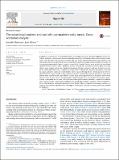Files in this item
The nutritional content and cost of supermarket ready-meals. Cross-sectional analysis
Item metadata
| dc.contributor.author | Remnant, Jennifer | |
| dc.contributor.author | Adams, Jean | |
| dc.date.accessioned | 2017-02-23T11:30:12Z | |
| dc.date.available | 2017-02-23T11:30:12Z | |
| dc.date.issued | 2015-09-01 | |
| dc.identifier | 249215353 | |
| dc.identifier | 74018e9e-a72b-4f02-8500-456ae5c3b31e | |
| dc.identifier | 84929617270 | |
| dc.identifier.citation | Remnant , J & Adams , J 2015 , ' The nutritional content and cost of supermarket ready-meals. Cross-sectional analysis ' , Appetite , vol. 92 , pp. 36-42 . https://doi.org/10.1016/j.appet.2015.04.069 | en |
| dc.identifier.issn | 0195-6663 | |
| dc.identifier.other | ORCID: /0000-0001-7562-1547/work/31642329 | |
| dc.identifier.uri | https://hdl.handle.net/10023/10339 | |
| dc.description | JA is currently funded by the Centre for Diet and Activity Research (CEDAR) MR/K023187/1, a UKCRC Public Health Research Centre of Excellence. Funding from the British Heart Foundation, Cancer Research UK, Economic and Social Research Council, Medical Research Council, the National Institute for Health Research, and the Wellcome Trust, under the auspices of the UK Clinical Research Collaboration, is gratefully acknowledged. | en |
| dc.description.abstract | Background: Over-reliance on convenience foods, including ready-meals, has been suggested as one contributor to obesity. Little research has systematically explored the nutritional content of supermarket ready-meals. We described the nutritional content and cost of UK supermarket ready-meals. Methods: We conducted a survey of supermarket own-brand chilled and frozen ready-meals available in branches of ten national supermarket chains in one city in northern England. Data on price, weight and nutritional content of meals in four ranges ('healthier', luxury, economy and standard) and of six types (macaroni cheese, meat lasagne, cottage pie, chicken tikka masala, fish pie, and sweet and sour chicken) were collected. Nutritional content was compared to ranges used to identify low, medium and high fat, saturated fat, sugar and salt in nationally recommended front-of-pack labelling. Results: 166 ready-meals were included from 41 stores. Overall, ready-meals were high in saturated fat and salt, and low in sugar. One-fifth of meals were low in fat, saturated fat, salt and sugar, including two-thirds of 'healthier' meals. Meals that were low for three out of the four front-of-pack nutrients were the cheapest. Conclusions: Supermarket ready-meals do not have a healthful nutritional profile overall. However, a number of healthier meals were available - particularly amongst meals specifically marked as 'healthier'. There was little evidence that healthier meals necessarily cost more. Further effort is required to encourage producers to improve the nutritional profile of the full range of ready-meals, and not just those specifically labelled as 'healthier'. | |
| dc.format.extent | 7 | |
| dc.format.extent | 481737 | |
| dc.language.iso | eng | |
| dc.relation.ispartof | Appetite | en |
| dc.subject | Diet | en |
| dc.subject | Economic cost | en |
| dc.subject | Food | en |
| dc.subject | Nutrition | en |
| dc.subject | RA0421 Public health. Hygiene. Preventive Medicine | en |
| dc.subject | H Social Sciences | en |
| dc.subject | Nutrition and Dietetics | en |
| dc.subject | Psychology(all) | en |
| dc.subject | NDAS | en |
| dc.subject | SDG 3 - Good Health and Well-being | en |
| dc.subject.lcc | RA0421 | en |
| dc.subject.lcc | H | en |
| dc.title | The nutritional content and cost of supermarket ready-meals. Cross-sectional analysis | en |
| dc.type | Journal article | en |
| dc.contributor.institution | University of St Andrews. Geography & Sustainable Development | en |
| dc.identifier.doi | 10.1016/j.appet.2015.04.069 | |
| dc.description.status | Peer reviewed | en |
This item appears in the following Collection(s)
Items in the St Andrews Research Repository are protected by copyright, with all rights reserved, unless otherwise indicated.

